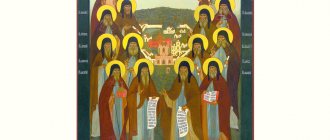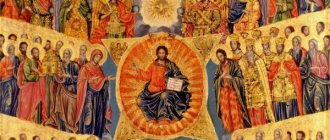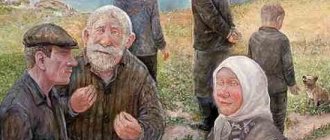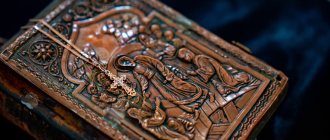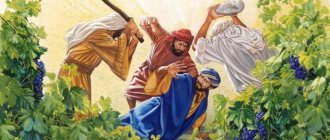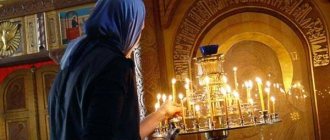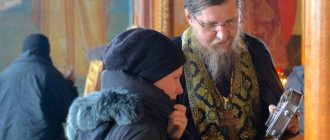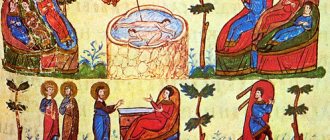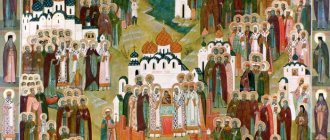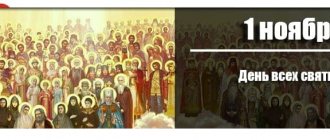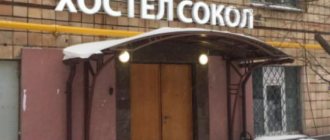Service to All Saints who have shone in the Russian Land
In May 1935, immediately after the opening of the metro, an unusual religious procession took place in Stalinist Moscow. Bishop Afanasy (Sakharov), with an icon of all Russian saints, rode the first and then only line from Sokolniki to Park of Culture, while reading prayers for the consecration of the capital’s new mode of transport. But then, this harmless act in modern times could cost him his life...
The choice of the icon was not accidental. Vladyka Athanasius was directly involved in its writing. He also spent almost thirty-five years compiling the service to All the Saints Who Shined in the Russian Land, and it is to him that we owe much of the revival of this ancient Orthodox holiday in our country.
PORTAL CONTACTS
“In songs let us praise the luminaries of the never-passed Russian land, the mysteries of the Divine Word, Christ glorifyingly, who enlightened these and loved and gave us help in sorrow...” (luminaries, tone 2, service to All Saints who shone in the lands of Russia), - this is how the Russian Orthodox Church glorifies all the saints who labored within Russian borders. The beautiful canon of All the Saints Who Shined in the Russian Land was written by Saint-Confessor Afanasy Kovrovsky (Sakharov; † 1962). A reverent man of prayer and a God-loving ascetic, he deeply revered the righteous people close to him in spirit who labored on Russian soil. It was with his blessing that the icon of All Russian Saints was painted by M. N. Sokolova (later Monk Juliana). No later than the end of 1933 - the beginning of 1934, Maria Nikolaevna received a blessing from St. Athanasius to paint for him a cell image of the Cathedral of Saints of the Russian Land.
In January - May 1934, the icon was painted.
This work was preceded by a long preparatory period. The iconography and composition of the saints were discussed in detail with St. Athanasius. “The memories of how the image of All the Saints who shone in the Russian land were still alive in my memory. Maria was about 30 years old at that time; she looked at hundreds of lives of saints, legends, articles, and books. She picked up huge iconographic material. In terms of the amount of spiritual knowledge and work invested by Mary, the image of All Russian Saints is equal to, and perhaps even surpasses, any doctoral dissertation. Hundreds of sketches and sketches were made, many, many hours were spent in prayers, thoughts, doubts...” (from the memoirs of V.V. Bykov). The image turned out to be so complete and harmonious that it is difficult to believe that this is a newly created composition. At the top are the Mother of God, St. John the Baptist, Archangels, saints of the Universal Church, standing before the Holy Trinity, and at the same time prayerfully supporting the ascetics and righteous people of the Russian land. Groups of Russian saints are collected by land and include saints, martyrs, saints, blessed ones, those standing before God and patronizing not only the places of their exploits, but also the entire Russian land.
“...As soon as the metro opened in Moscow, Vladyka Afanasy with this icon traveled from Sokolniki to the Park of Culture. And he said: “This metro was consecrated by me with the icon of All Russian Saints.” I passed with this icon and read all the prayers for the consecration of this metro,” recalled Vladyka Afanasy’s cell attendant N.S. Fiolentova.
The Service to All Saints Who Shined in the Land of Russia appeared 20 years later than the icon, but this was primarily due to the difficult circumstances of the life of the Bishop-Confessor, his many years in chains and imprisonment. He completed his work on the service to All Russian Saints in 1953. In 1954, the cell icon of Bishop Athanasius, painted by M. N. Sokolova, visited the first patronal feast in the Trinity-Sergius Lavra, in the temple in honor of this feast, located in the crypt of the Assumption Cathedral.
He wrote about this to Maria Nikolaevna: “I was very consoled by the fact that the icon of All Russian Saints that you painted, the first of its kind, was at the first temple festival in the first permanent Church of All Russian Saints, created in the Trinity, dear to all Russian people. Sergius Lavra. I even regret that then the thought did not occur to me to leave this holy icon there as a temple icon forever. I think that there is already such an icon there, and it was written by your own hand. But I would like to leave the “original” there, and not a copy. Maybe this will work out? I love this holy icon very much and value it, but I would gladly give it up for my native Lavra. If you have any connections with the Lavra, I would only be grateful to you if you arranged this program.
I would just like to see its history written on the back of the icon, something like this: “This holy image of All Saints who shone in the Russian Land, the first in such (composition), with the blessing and direction of His Grace Athanasius, Bishop of Kovrov, was written in the city Moscow by icon painter Maria Nikolaevna Sokolova, in the summer from the creation of the world 7442, from the Nativity according to the flesh of God the Word 1934, in the months of January-May. This image was consecrated by His Eminence Athanasius after Little Vespers on the Sunday of All Saints, who shone forth in the Russian Land, on May 27-June of the same year during a service in the home church of the hieromonk of the Trinity-Sergius Lavra Ieraks in the village of Losino-Ostrovskaya, Moscow region, with the participation of the choir of Moscow St. Nicholas, what is in the Klenniki church.”
Very few people should know about this inscription, and after writing it, the back side of the icon will need to be covered with some kind of material. I would like to highlight in the inscription that the icon you painted is the first with such an arrangement of saints. Before your icon of All Russian Saints, but in a different arrangement, there is an ancient icon known to you. It was published in parts in the album of the Museum of the Petrograd Theological Academy. The second of the same kind, shortly before yours, was written in Staraya Russa by Archpriest V. Pylaev. Now she is in the Patriarch's office.
And one more note about our icon. It seems that it will need to be supplemented with two images. I heard that a tradition is kept in Alma-Ata that the Apostle Matthew was there, but I don’t know for sure: the evangelist or Matthew, chosen to replace Judas, and that in Zhelobod (in Central Asia) the grave of the righteous Job is kept and highly revered. This all needs to be thoroughly checked. And if this is true, then both the righteous Job and the holy Apostle should be depicted in the guise of heavenly prayer books for the Russian Land, next to the prophet Elijah and the Apostle.
Forgive me, my dear, that with my first letter I turn to you with requests and instructions. But everything that concerns our holiday and our icon is very dear to me, and I hasten to express my wishes, because I don’t know what the coming day will give rise to ... "
In another letter of his, dated September 30, 1959, Saint Athanasius mentions that “Metropolitan Nestor will also be in the Lavra, who will look for you to negotiate about the icon of All Russian Saints...”
According to the testimony of Archpriest Vladimir Vorobyov, the icon of All Russian Saints was painted by Mother and for Metropolitan Leonid of Riga and Latvia (Polyakov, † 1990), and this icon is still in the Baltic states. There are known icons of the cathedral of Russian saints, located in the Moscow Danilov Monastery, in the cathedral of the city of Tutaev-Borisoglebsk. Two icons of Russian saints, painted by Mother Juliania - the cell icon of St. Athanasius and the temple icon, painted for the Lavra Church of All Russian Saints, are still in the Trinity-Sergius Lavra.
Thus, nun Juliania painted at least 5 icons of All Russian Saints. While differing slightly in detail, in general they retained the composition and color scheme of the original icon.
Saint Athanasius departed to the Lord in 1962, and in 2000 he was canonized by the Russian Orthodox Church. In 1981, Mother Juliana passed away.
New and new saints appear in the cathedral of Russian righteous people in the historical course of time. Let us not forget to address them on this special day for the Russian Church - the feast of All Russian Saints, both known to us and remaining hidden from people, but known to God, shining like many stars in the Kingdom of Heaven:
“As the darkness thickens at night, the starry shine increases, and to this the eyes of the lost are joyfully raised. Thus, to the sinful darkness that has multiplied on the earth, let us lift up our eyes to grief, brethren, and, seeing the radiance of the spiritual stars illuminating our land, we are sweating towards the Heavenly Fatherland; may the Lord not deprive us, sinners, of it through the prayers of his saints...” (sedalen, voice 7, service to all saints who have shone in the Russian lands).
Website of the Holy Trinity Sergius Lavra
Day of All Saints who have shone in the Russian Land
The Church celebrates this holiday every year on the second Sunday after the Holy Trinity. So, for example, in 2022, the memory of all the saints in the Russian Land who have shone forth is celebrated on July 4th.
Initially, the holiday appeared in the church calendar back in the 16th century, when, at the instigation of the famous Metropolitan Macarius, the canonization of many Russian saints took place. However, then the tradition of the celebration did not take root - the Time of Troubles and the reforms of Patriarch Nikon (Dmitry Volodikhin wrote about Patriarch Nikon in Thomas) led to a break in the Russian church tradition, and the holiday was never fixed in the calendar.
The Local Council of 1917-18 tried to correct the situation. In an era of new civil unrest, the prayerful help of the saints of the Russian land was more useful than ever. The council decided to restore the day of all Russian saints in the church calendar, and Bishop Afanasy (Sakharov) began to work on compiling a new service.
He partly used old texts from the 16th century, but as a result only a few chants were taken from them. To a large extent, the service was written by Bishop Athanasius virtually from scratch.
Work proceeded slowly, which was due to external circumstances. Bishop Athanasius went through years of prison and exile; during the 33 years of his episcopate, he, in his own words: “was in diocesan service for 33 months; at large, out of work - 32 months, in exile - 76 months, in prison and in bitter labor - 254 months...” Bishop Afanasy finished work on the text of the service to the Russian saints only in 1953. After that, until his death in 1962, he edited and supplemented it.
The service, edited and supplemented by Bishop Athanasius, was first published in the May Menaion (a collection of services to the saints) in 1987. Later, it was also improved, but only slightly: for example, new names were added to the text of the service. And in 2000, its author became its “addressee”: Bishop Athanasius was glorified among the new martyrs and confessors of Russia, which means he joined the Council of all the saints who have shone in the Russian land.
Russia's difficult path
This war stopped the destruction of the Church. The Church has always shared the fate of the country and the people. And already on the first day of the war, when the country’s political leadership was silent, the future patriarch, Metropolitan Sergius, having served a prayer service for the victory of Russian weapons, said in a sermon:
“Let the storm come. We know that it will bring not only happiness, but also relief; it will purify the air and remove toxic fumes.”
Rus' has had a difficult road ahead. Throughout history, she was forced to fight against numerous strong, merciless enemies. They often threatened her with complete destruction. Neither the sea, nor the mountains, nor the desert protected the homeland from these enemies. After all, Russia is located on a wide plain open on all sides.
The hordes of Batu and Mamai came towards it from the east, and the Poles, Napoleon and Hitler from the west. From the north - Swedes, from the south - Turks. And at the same time difficult climatic and natural conditions. Half of Russia's territory is permafrost, where farming is impossible. It is possible in the southern part. But this territory is completely open. It is not protected from military invasions and raids of steppe predators. Therefore, people in Russia have always lived relatively poorly. Even what they managed to accumulate was often destroyed, captured, burned to the ground by the next invasion or raid.
What does it mean to live a Christian life?
Yes, life in Russia was not cloudless and easy. But from a Christian point of view, this is exactly what the life of God’s people should be. Not a single Orthodox people lived a serene, safe and comfortable life. The reason for this is clear: man is weak. If you give him all the comforts and a luxurious life, he easily forgets God. He forgets everything heavenly and turns completely to the earth, drowning in the dust of the earth.
That is why the Lord did not give His people such a life. Venerable Isaac of Syria says:
“This is how the sons of God differ from others, that they live in sorrows, while the world rejoices in pleasure and peace. For God did not wish that His beloved should rest while they were in the body, but rather He willed that while they were in the world, they should remain in sorrow, in hardship, in labor, in poverty, in nakedness, in loneliness, need, illness, humiliation , in insults, in heartfelt contrition..."
This is the way the Lord leads all His true followers. Having become a man, he walked in our world exactly this way - the path of the cross.
But why does the Lord not allow His people wealth and luxury? To understand this, we must remember what kind of land we live on. Remember that our land is not a place of entertainment and pleasure. And this is the place where we were expelled from Paradise. This is the place of our punishment and correction. We live in a corruptible, fallen and damaged world. In a world where death reigns, where everything is saturated with it. We live in a territory occupied by the devil and death. Moreover, we live for a short time, which we must devote to the struggle. The struggle to fulfill God's commandments. On earth we live as if at war, as if at the front. Is it therefore possible for Christians to settle here with all the comforts and luxuries?
A satiated life does not produce saints
This does not mean, of course, that the people of God are doomed to complete poverty and ruin. For the lives of ragamuffins, homeless people and street children. No, the Lord gives us everything we need for earthly life. For, in His own words, He knows that we have need of this. But the Lord does not allow His people excessive wealth, excesses and a satiated life. Because then the people cease to be the people of God, they cease to give birth to saints.
The Lord wisely leads His people along the middle path, the path of moderate poverty. In this way He led the people of Israel in Old Testament times. The country has never had earthly splendor, wealth, culture, like in Egypt, Greece, Rome. And along this same path He led all truly Christian, Orthodox peoples during the New Testament. He knows that only on this path did the people of God give birth to saints and righteous people.
Service to all the saints who have shone in the Russian Land
The full text of the service to all the saints who have shone in the Russian Land is available here
The text compiled by Bishop Athanasius is an amazing “verbal icon” of the persecuted Russian Church of the twentieth century. In the stichera on Lithia, the persecuted earthly Church asks the Russian saints to pray to God for the suffering Motherland and the Orthodox Christians who now live as persecuted and naked captives in a foreign land:
Voice 5. Similar to: Rejoice: Come, our heavenly representatives, to us, / who demand your merciful visit, / and deliver those embittered by the tormenting reproaches / and the fierce fury of the infidels, / from lower, like captives and Nazis, drive us away, / from the place to the place is often transitory/ and misleading in dens and mountains./ Be generous to us, O praisers,/ and grant us relief,/ quench the storm,/ and quench even the indignation against us,/ praying to God,/ giving I have great mercy upon you from our land.
At the end of Great Vespers, you can hear the stichera, stunning in beauty and meaning, written by Metropolitan Sergius (Stragorodsky) and the author of the 16th century service to the Russian saint, monk Gregory.
The texts of the service mention only a small part of Russian saints, since just listing the names of Russian ascetics can take several hours, as can be seen by opening the synodikon of Russian saints (text of the synodikon according to the 2006 version of the website pravoslavie.ru), which is read on this day in some Orthodox churches.
Prayer before the icon
Holy God and rest in the saints, glorified by the angels with a thrice-holy voice in heaven, praised on earth by man in His saints, giving grace to each by Your Holy Spirit according to the bestowal of Christ, and by that ordaining to the Church of Your Holy Ones apostles, prophets, and evangelists , you are shepherds and teachers, whose word of preaching, to You who acts all in all, has been accomplished in many ways, saints in every generation and generation, having pleased You with various benefactors, and to You, having left us the image of your good deeds, in the joy that has passed, prepare, in He himself was tempted, and he helped us those who were attacked. All these saints and (the name of the saint) remembering and praising their godly lives, I praise You Samago, who acted in them, and believing in Your goodness, the gift of being, I diligently pray to You, Holy of Holies, grant to me a sinner to follow their teaching, life, love, faith, long-suffering, and their prayerful help, and moreover Your all-effective grace, the heavenly ones with them will be honored with glory, praising Your Most Holy Name, the Father and the Son and the Holy Spirit forever. Amen.
( 4 ratings, average: 4.50 out of 5)
Icon of all Russian saints nun Juliania (Sokolova)
“All the saints who shone in the Russian land.” Icon. 1934 (Trinity Cathedral of the Trinity-Sergius Lavra)
Maria Nikolaevna Sokolova (in the monastic name Juliana) began painting the icon “The Council of All Saints Who Have Shined in the Russian Land” in the 1930s with the blessing of the priestly confessor Athanasius (Sakharov). For each saint who appeared on the image, the icon painter searched for information from lives and other sources in order to find an exact likeness of the iconographic image.
Bishop Athanasius described in detail the design of this icon. It depicts Kyiv and Moscow. The first city is like the foundation of Russian Orthodoxy, and the second is like its core. The icon also depicts the Assumption Cathedral of the Moscow Kremlin as the main shrine, three icons of the Mother of God associated with Russia - the Vladimir, Kazan and Novgorod “Sign”, as well as many saints.
The image, painted by nun Juliania in 1934, is kept in the sacristy of the Trinity-Sergius Lavra. Of course, it was physically impossible to depict all the Russian saints on it (even without taking into account the new martyrs), and before us is more an image of holiness than a literal image of all Russian saints.
List of saints
This is a list of glorified Great Christian saints, divided by holiness: Prophets, Apostles, Saints, Martyrs, Reverends. First on the list are the glorified saints with the prefix “Great”. But also the most revered, in several Christian denominations (both in Eastern Christianity and Western Christianity), saints are equal in veneration to the Great Saints.
This list can be used to develop articles: Christianity and Orthodoxy, as well as to create new articles on this topic, for example, such as: Great biblical prophets, Great Christian saints.
A complete list of all saints can be viewed at this link https://ru.wikipedia.org/wiki/List_of_great_Christian_saints
